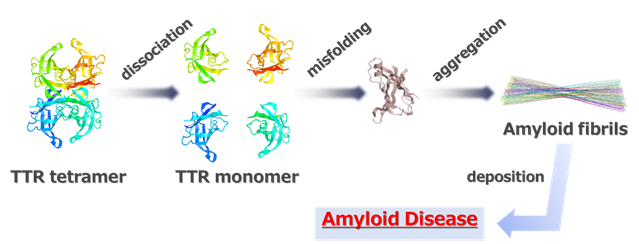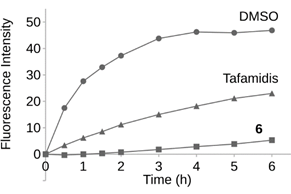Discovery of Novel Flavanone Derivatives as Candidate Compounds for the Treatment of Intractable Amyloid Disease
Summary
A research group led by Professor Naoki Toyooka and Assistant Professor Takuya Okada of Faculty of Engineering, University of Toyama, and Professor Mineyuki Mizuguchi and Assistant Professor Takeshi Yokoyama of Faculty of Pharmaceutical Sciences of the same university, has successfully created a new flavanone derivative 6 as a compound that could be applied to a new small molecule drug for amyloid disease, an intractable disease. Transthyretin (TTR) is a stable protein, but when amyloid fibers are formed under certain conditions or due to genetic factors, they are deposited in the heart, eyes, and peripheral nerves, causing serious functional disorders. This is called amyloid disease and is designated as an intractable disease. Tafamidis (Vindakel) is the only effective small molecule drug against this disease. In this study, we found that the newly synthesized compound 6 has the same level of inhibition of amyloid fibril formation as tafamidis, and that compound 6 binds to TTR more potently than tafamidis in human plasma. Furthermore, pharmacokinetic studies showed that compound 6 was transferred to the eye more significantly than tafamidis, indicating that compound 6 is extremely promising as a new therapeutic agent for amyloidosis targeting TTR not only in plasma but also in the eye.
The research results were published online in the Journal of Medicinal Chemistry, on Tuesday, December 6, 2022, at 10:00 PM (JST) (Tuesday, December 6, 2022, at 1:00 PM (GMT)).
Research Background
Transthyretin (TTR) is a tetrameric protein synthesized primarily in the liver and is responsible for the transport of thyroxine and retinol. Normally, TTR is a stable protein, but when the tetramer dissociates and aggregates into a monomer under certain conditions or due to genetic factors, insoluble amyloid fibers are formed, which can cause serious functional disorders when deposited in the heart, eyes, peripheral nerves, etc. (Figure 1). This is called amyloid disease and is designated as an intractable disease.

Figure 1. Pathogenesis of Amyloid Disease
Although liver transplantation is an effective treatment for this disease, the shortage of donors and loss of vision due to glaucoma and vitreous opacity after transplantation are major problems. Although tafamidis (vindakel) is currently reported as an effective small molecule drug, it does not show a certain level of efficacy in ocular amyloidosis, so there is an urgent need to develop new therapeutic agents that target the TTR in the eye. Therefore, we attempted to create a new flavanone derivative based on naringenin (IC50 value 12 μM), which has been reported to inhibit amyloid fibrillogenesis (Figure 2).

Figure 2. Design of Novel Flavanone Derivatives
Research Content and Results
Among the new flavanone derivatives, we found that compound 6 (IC50 value 3.7 μM) exhibited an inhibition of amyloid fibrillogenesis comparable to that of tafamidis (IC50 value 5.5 μM), an existing drug for amyloid disease (Figure 3).

Figure 3. Structure of Naringenin, Compound 6, and Tafamidis with Their IC50 Value Evaluation of the binding ability of the compound 6 to TTR in human plasma revealed that compound 6 binds to TTR more potently than tafamidis (Figure 4).

Figure 4. Evaluation of Binding Ability of Compound 6 to TTR in Human Plasma Furthermore, pharmacokinetic studies in rats showed that compound 6 was significantly transferred to the eye compared to tafamidis. These results suggest that 6 is extremely promising as a novel therapeutic agent for amyloidosis targeting TTR not only in plasma but also in the eye.
Title
Chlorinated Naringenin Analogs as Potential Inhibitors of Transthyretin Amyloidogenesis
Authors
Mineyuki Mizuguchi1,*, Yusuke Nakagawa2, Kishin Inui3, Wakana Katayama1, Yurika Sawai4, Ayaka Shimane1, Ryota Kitakami5, Takuya Okada4,*, Yuko Nabeshima1, Takeshi Yokoyama1, Kayoko Kanamitsu6, Shinsaku Nakagawa7, Naoki Toyooka4,*
1 Faculty of Pharmaceutical Sciences, University of Toyama, Toyama, 930-0914, Japan
2 Graduate School of Innovative Life Science, University of Toyama, Toyama 930-8555, Japan
3 Graduate School of Science and Engineering, University of Toyama, Toyama 930-8555, Japan
4 Faculty of Engineering, University of Toyama, Toyama 930-8555, Japan
5 Graduate School of Medicine and Pharmaceutical Sciences, University of Toyama, Toyama 930-0194, Japan
6 Drug Discovery Initiative, the University of Tokyo, Tokyo 113-0033, Japan
7 Graduate School of Pharmaceutical Sciences, Osaka University, Osaka 565-0871, Japan

